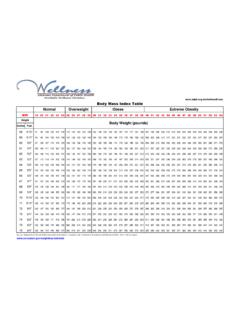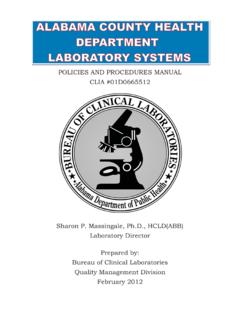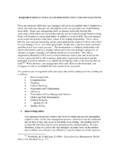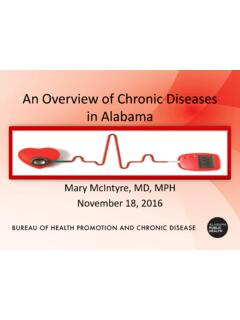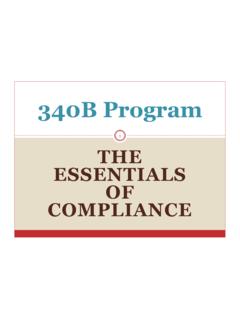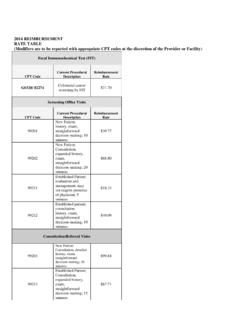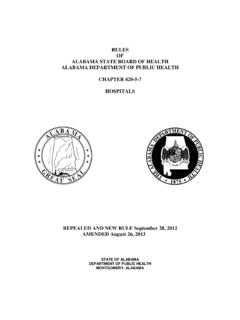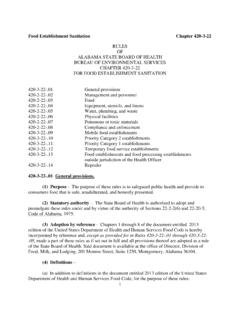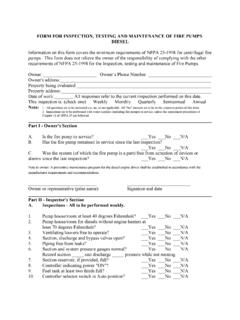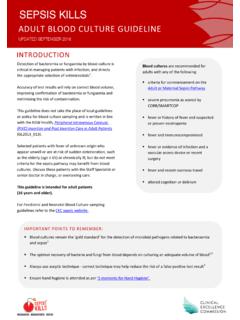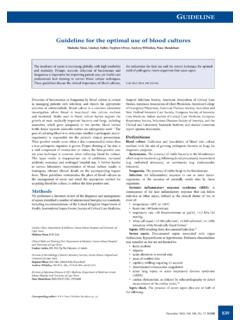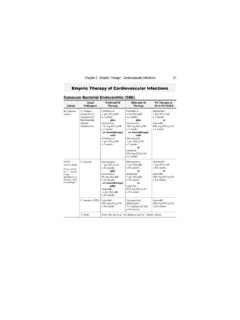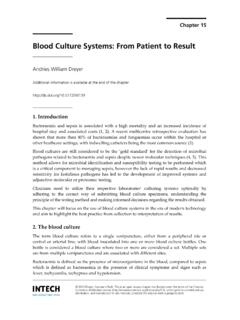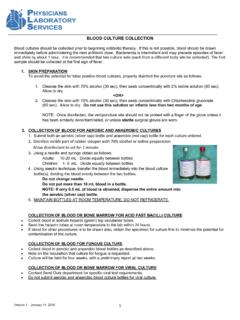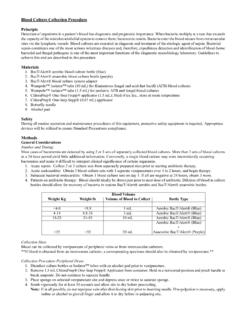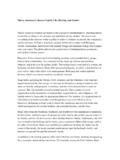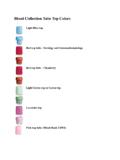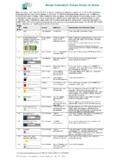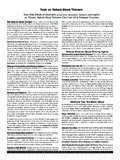Transcription of BLOODBORNE PATHOGENS EXPOSURE PLAN
1 ALABAMA DEPARTMENT OF PUBLIC HEALTH BLOODBORNE PATHOGENS EXPOSURE plan INFECTION PREVENTION BUREAU OF COMMUNICABLE DISEASE 334-206-5932 ADPH-DC-REV. 2-2013 BLOODBORNE PATHOGENS EXPOSURE plan 2 February 2013 TABLE OF CONTENTS I..3 II. Definitions ..4 III. EXPOSURE Determination ..6 IV. Standard Precautions ..7 V. 2001 Needlestick Safety and Prevention Act ..7 VI. Engineering and Work Practice Controls ..8 A. Sharp Containers ..8 B. Handwashing Facilities ..9 C. Work Area Restrictions ..9 D. Specimen Handling ..10 E. Equipment Handling ..10 F. Cleaning & Disinfection ..11 G. Sterilization ..11 VII. Personal Protective Equipment (PPE).
2 11 VIII. Housekeeping ..14 IX. Regulated Waste Disposal ..15 A. Regulated Waste Containment ..15 B. Discarding & Containment of Contaminated Sharps ..15 X. Contaminated Laundry ..16 XI. Hazard Communication (Specific Labeling) ..17 XII. Special Situations ..18 A. Laboratories ..18 B. Home Health ..18 XIII. Hepatitis B Vaccination ..19 XlV. EXPOSURE Incident Evaluation Procedures ..20 XV. Post EXPOSURE Evaluation and Follow-up ..21 XVI. Information and Training ..22 XVII. Recordkeeping ..24 XVIII. EXPOSURE plan Review ..24 XIX. Appendix A: Employee Contract ..25 XX. Appendix B: Employee Hepatitis Declination Form ..26 XXI. Attachments: SEICTF BLOODBORNE PATHOGENS EXPOSURE plan 3 February 2013 I.
3 INTRODUCTION This BLOODBORNE PATHOGENS EXPOSURE Control plan was developed by the ADPH as a means to minimize employee EXPOSURE to human blood and other potentially infectious materials. It is designed to comply with the standards enunciated by the United States Department of Labor, Occupational Safety and Health Administration (OSHA) in Part 19101030, Title 29 of the Code of Federal Regulations, "Occupational EXPOSURE to BLOODBORNE PATHOGENS ". Each employee, whose work duties involve reasonably anticipated EXPOSURE to blood or other potentially infectious materials, must become familiar with, and adhere to, the provisions of the EXPOSURE Control plan . In order to promote this objective, a copy of the plan shall be readily accessible to all employees.
4 In this facility the plan will be available from: _____ (name/position) This plan will be reviewed and updated at least annually and whenever necessary to reflect new or modified tasks and procedures which would affect occupational EXPOSURE . In addition, it will be updated as necessary to reflect new or revised employee positions which have been ascertained to be at potential occupational risk to EXPOSURE to BLOODBORNE PATHOGENS . Within each county health department one or more individuals will have the authority and responsibility for the implementation of this plan . The person(s) responsible for _____ County is (are): _____ (name/position) ___/___/___ (Effective date of this EXPOSURE Control plan ) BLOODBORNE PATHOGENS EXPOSURE plan 4 February 2013 II.
5 DEFINITIONS These definitions apply throughout this plan : " blood " means human blood , human blood components, and products made from human blood . " BLOODBORNE PATHOGENS " refers to pathogenic microorganisms that are present in human blood and can cause disease in humans. These PATHOGENS include, but are not limited to, hepatitis B virus (HBV), hepatitis C virus (HCV), and human immunodeficiency virus (HIV). "CLINICAL LABORATORY" means a workplace where diagnostic or other screening procedures are performed on blood or other potentially infectious materials. "CONTAMINATED" means the presence, or the reasonably anticipated presence, of blood or other potentially infectious materials on an item or surface.
6 "CONTAMINATED LAUNDRY" means laundry which has been soiled with blood or other potentially infectious materials or which may contain sharps. "CONTAMINATED SHARPS" means any contaminated object that can penetrate the skin including, but not limited to, needles, scalpels, broken glass, broken capillary tubes, and exposed ends of dental wires. "DECONTAMINATE" means the use of physical or chemical means to remove, inactivate, or destroy BLOODBORNE PATHOGENS on a surface or item to the point where they are no longer capable of transmitting infectious particles and the surface or item is rendered safe for handling, use, or disposal. "ENGINEERING CONTROLS" are those controls which isolate or remove the blood borne PATHOGENS hazard from the workplace (sharps disposal containers and self-sheathing needles).
7 Safer medical devices such as sharps with engineered sharps injury protections and needleless systems must be used where feasible. " EXPOSURE INCIDENT" means a specific eye, mouth, or other mucous membrane, non-intact skin, or parenteral contact with blood or other potentially infectious materials that results from the performance of an employee's duties. "HBV" means Hepatitis B virus. "HCV" means Hepatitis C virus BLOODBORNE PATHOGENS EXPOSURE plan 5 February 2013 "HIV" means Human Immunodeficiency Virus. "NEEDLELESS SYSTEMS" means devices which provide an alternative to using needles for various procedures in order to reduce the risk of injury involving contaminated sharps.
8 Examples include: IV medication systems which administer medication or fluids through a catheter port using non-needle connections; and Jet injection systems which deliver liquid medication beneath the skin or through a muscle. "OCCUPATIONAL EXPOSURE " means reasonably anticipated skin, eye, mucous membrane, or parenteral contact with blood or other potentially infectious materials that may result from the performance of an employee's duties. "OTHER POTENTIALLY INFECTIOUS MATERIAL" (OPIM) means: the following human body fluids: semen, vaginal secretions, breast milk, cerebrospinal fluid, synovial fluid, pleural fluid, pericardial fluid, peritoneal fluid, amniotic fluid, saliva, any body fluid that is visibly contaminated with blood , and all body fluids in situations where it is difficult or impossible to differentiate between body fluids; any unfixed tissue or organ (other than intact skin) from a human (living or dead); and HIV-containing cells or tissue cultures, organ cultures, and HIV, HCV or HBV-containing culture medium or other solutions.
9 And blood , organs, or other tissues from experimental animals infected with HIV, HCV or HBV. "PARENTERAL" means piercing mucous membranes or the skin barrier through such events as needlesticks, human bites, cuts, and abrasions. "PERSONAL PROTECTIVE EQUIPMENT" means specialized clothing or equipment worn by an employee for protection against a hazard. General work clothes ( , uniforms, pants, shirts or blouses) not intended to function as protection against a hazard are not considered to be personal protective equipment. "REGULATED WASTE" means liquid or semi-liquid blood or other potentially infectious materials; contaminated items that would release blood or other potentially infectious materials in a liquid or semi-liquid state if compressed; items that are caked with dried blood or other potentially infectious materials and are capable of releasing these materials during handling; contaminated sharps; and pathological and microbiological wastes containing blood or other potentially infectious materials.
10 "SHARPS WITH ENGINEERED SHARPS INJURY PROTECTIONS (SESIPS) includes non-needle sharps or needle devices containing built-in safety features that are used for collecting fluids or administering medications or other fluids, or other procedures involving the risk of sharps injury. Examples include: needles that retract into a syringe after use, syringes with a sliding sheath that shields the attached needle after BLOODBORNE PATHOGENS EXPOSURE plan 6 February 2013 use, and IV delivery systems that use a catheter port with a needle housed in a protective covering. "SOURCE INDIVIDUAL" means any person, living or dead, whose blood or other potentially infectious materials may be a source of occupational EXPOSURE to the employee.

